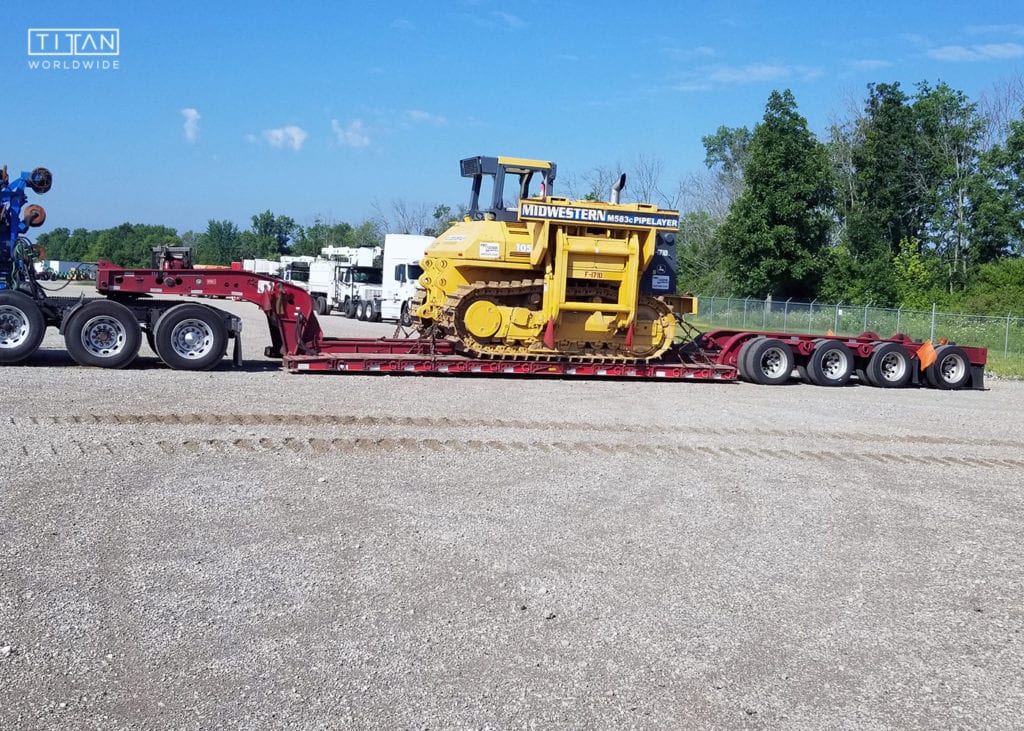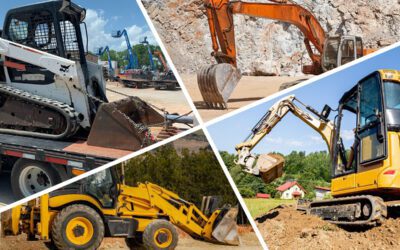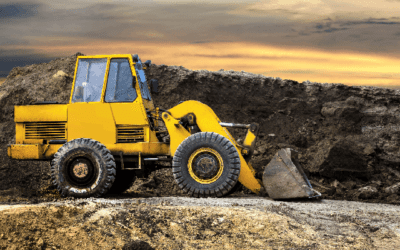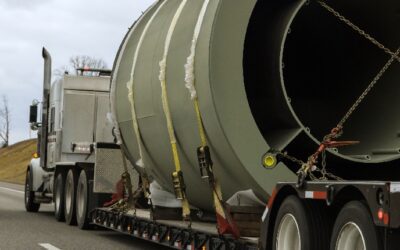How to Load a Bulldozer
Loading a heavy piece of machinery is no easy task, but you already knew that – right when you were using a bulldozer hauling service? However, when it comes to loading a bulldozer, it’s no less than a nightmare. You see, a bulldozer is a massive piece of machinery used for pushing large quantities of rubble, sand and soil out of the way during construction works. You cannot imagine a successful construction project without a bulldozer.
Risks Involved with Loading a Bulldozer
Loading a bulldozer and other heavy construction equipment on and off trailers and flatbed trucks is so common nowadays when bulldozer hauling, that construction companies hardly even give it a second thought. A recent survey reported the number of injuries and fatalities that took place while loading a bulldozer, and the numbers are ridiculously high.
A study by the Census of Fatal Occupational Injuries reported that nine construction workers are killed each year while loading and unloading bulldozers. 75 percent of the cases of deaths took place because of the overturn of equipment pieces as they were consistently driven on and off the trailer. Another major cause of injury was the worker being stuck between the trailer and the bulldozer – talk about being stuck at work.
In another survey, 63 deaths were examined, and the highest number of deaths occurred among the operators of heavy equipment: loader operators, scraper operator, dozer, sever grader and other miscellaneous equipment operators. 35 percent of the death occurred between this group while the remaining groups who suffered injuries were administrators, managers, truck drivers, construction laborers and supervisors.
There were several other reasons found in the reports while loading heavy construction equipment. Parking the trailer on unstable ground or a slope or maybe using a ramp or trailer that just wasn’t big enough.
Loading a Bulldozer – Steps to follow
So how do you load such a heavy piece of machinery? For that, you need to follow the guidelines provided below as it is not only the best practice – it is the only practice.
1. Designate Duties
Before you start the loading process, make sure every involved person understands his or her responsibilities. Given the complexities involved in loading a bulldozer, everyone needs to know their part. Some of the duties that are often part of the process are:
- The driver who will take the equipment on the deck
- A spotter to give hand signals and direct the driver and to make sure he doesn’t make matters worse otherwise, he would not be anything less than a blind guy driving a truck on the highway.
The rest of the crew needs to be notified if the procedure of loading will take place on the dock. No vehicles or drifting personnel must interrupt the loading operations which are not generally safe, once the process gets started.
2. Keep it clean, silly!
Do you want your construction project to go down the drain on the very first day? Let’s assume you don’t then make sure the ramp and the trailer are clean as hell. Everything should be debris, oil and dirt free, especially if you are working with metal. This ensures that there is enough traction on the ramp to easily load the bulldozer up.
A clean trailer and ramp bed also mean that it needs to be clear of water, snow and ice. If you still are concerned about equipment moving up the ramp smoothly, they consider having frictionless devices for the ramp.
3. Clear and Leveled Loading Area
Pick a place for loading that is even and uninhabited for setting up the ramp and successfully perform the loading of heavy equipment. This step is primarily based on intuition so, do it in the midst of the day or at peak hours, before the process takes place.
Also, make sure that the loading area is compact enough and appropriate for handling the entire weight of the loaded trailer. After rain or thaw seasons, the combined weight of the two can more likely cause sinkage.
4. Choosing the Right Trailer
So, you’ve finally got a project that requires transportation of all your heavy machinery to a specific location. Your first step should be to choose an appropriate transportation tool when bulldozer hauling. What is the ideal transportation tool you ask? Well, for starters, the vehicle needs to have adequate capacity and space that can accommodate that huge monstrosity.
You need a trailer that can accommodate the size and weight of that bulldozer with ease, along with all its attachments. If you are transporting large-size bulldozers, you are more likely looking for an RGN trailer to facilitate your transportation needs. However, if you are transporting a smaller bulldozer, you don’t need to worry about large trailers, step decks or hotshot trailers would work as well. It all depends on what type of equipment that requires transporting.
It is highly recommended that you seek advisory services from hauling experts like Titan Worldwide so that you never have to worry about inefficient vehicle transportation and get exactly what’s right.
5. Follow the Suggested Guidelines
Always read the owner’s manual, emphasis on the word ALWAYS! You see, most construction company owners overlook the importance of the instructions manual. Remember, it is there for a reason and probably because it works. It is critical that you read the guidelines in the owner’s manual as it will ensure the safe and secure transportation of the bulldozer. Here are some of the key pointers we would like to share with you.
- Make sure that the trailer or the vehicle is firmly parked on the ground. One minor slip or unexpected movement can bulldoze your entire project (pun intended).
- Ensure that the equipment and the ramp don’t have any grease, mud, or debris on them to keep the friction intact and prevent anything from sliding that can potentially damage the bulldozer.
- Run the bulldozer’s engine at the lowest possible speed. This will ensure that the bulldozer makes its way into the trailer preventing any damage and avoidable accidents from taking place.
- Check if the ramp design of the vehicle is ideal for the bulldozer and is able to accommodate its size and weight. Add some blocking if you find it necessary, under the ramp, for enhancing the support.
- Here’s a piece of expert advice – always load the most massive part of the bulldozer first when getting prepped for bulldozer hauling. Why, you ask? It is because that requires the most amount of space and that needs to be your prime concern. So, put load the bulldozer in a reverse manner inside the trailer.
- Last but certainly not least, make sure the bulldozer’s weight is evenly distributed inside the transporting vehicle. The even weight will make sure no unnecessary pull and tire take place during the process. The best way to confirm the even distribution and whether the device is balanced or not is to check the suspensions of the trailer or the vehicle.
6. Proper Positioning and Securing
- Before the process of transportation begins, you need to make sure that all the covers, doors and the articulation points on the bulldozer have articulated lock frames to prevent all sorts of possible articulations that can take place during the transit.
- Lower or bring down the attachment of the bulldozer to the floor of the vehicle, turn the engine and the battery off.
- Place all the tie downs in the rear and front tie-down positions. Make sure you always use the recommended connection and securement points to minimize the damage and maximize effectiveness during transportation.
- Place your wedges, cradles, chocks and other means in from of and behind — each track or wheel for preventing any rolling and shifting of the bulldozer during equipment transportation.
- Verify pressure of the bulldozer’s tires to prevent loosening of the tie-downs. It is recommended that you refer the manual provided by the owner for proper tire pounds of pressure
- Carry out a thorough inspection of the tie-down equipment and the points that are used for securing the equipment. Do ensure, all the pins and connection points are secure, and all the hooks are functional.
7. Securing the Attachment of the Bulldozer with Proper Implementation
During the process of loading and transportation, it is essential to make sure that the attachments of the bulldozer hauling are efficiently secured. These attachments can be secured with the bulldozer or separately in the same trailer. Chains can be used for securing the attachment and accessories safely.
If the bulldozer is equipped with the hydraulic attachments, then ensure that the orientation of the hoses doesn’t interfere with the machine on the trailer. All hoses need to be placed under the device, connected in a manner that disengaging them later doesn’t become a hassle. You also need to make sure that all the hoses show compliance with the owner’s manual before the process begins.
If you follow all the guidelines appropriately, loading a bulldozer would not seem complicated. We recommend you keep an eye on the manual and carry out the process while looking at it, then it will not look so complicated. You need to make sure that everything is followed appropriately and exactly as it will help you in ensuring the safety and security of the bulldozer.
Be Smart, Be Responsible – that should be your motto.
8. Choose the Right Heavy Hauling Service
Careful analysis of the right hauling services is a critical aspect for any construction industry. There are several hauling services in the market that make plenty of promises. However, you should always choose the one with experienced personnel and long-list of satisfied clienteles. Remember, the slightest mistake can cause you to lose millions. One step in the wrong direction can lead to several more.
Outsourcing your services to the right third-party company is just like finding the perfect mate for yourself. Think for a second, there is money involved, liabilities are shared, and it only takes a silly mistake to start a fight.
Check out our bulldozer transport services.




